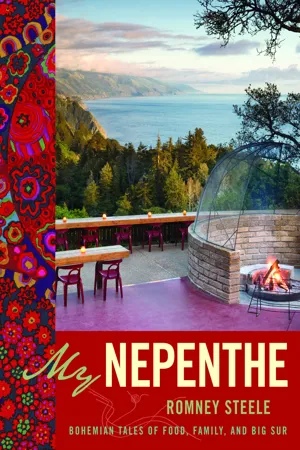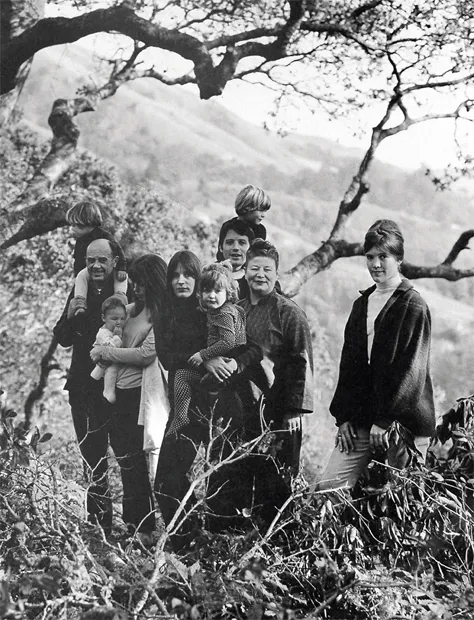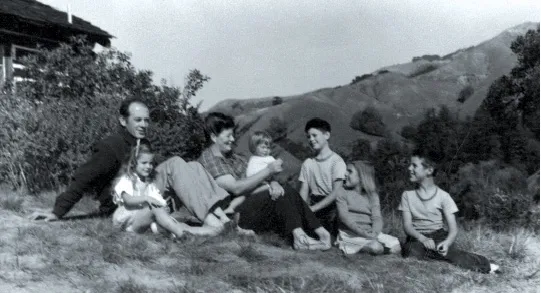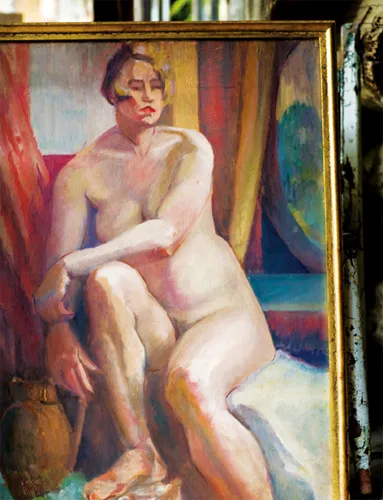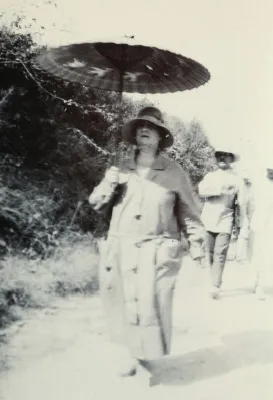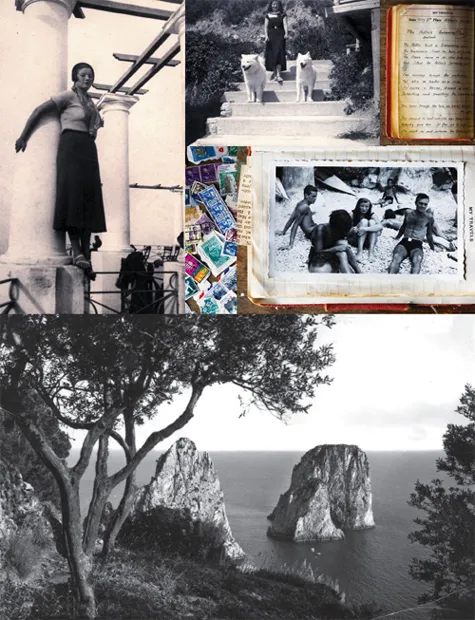![]()
CHAPTER 1
My Family’s Story
The Fassett family, 1966
{1}
MY FAMILY’S STORY
My family’s story in Big Sur began in 1947, when my grandparents William and Madeleine Fassett, better known as Bill and Lolly, bought a rustic log cabin on a grassy knoll surrounded by oak trees and moved in with their five children: Griff, Kaffe, Dorcas Jane, Holly, and Kim, my mother, who was just nine months old.
The cabin, built in 1925 by homesteader Sam Trotter for the Trails Club, overlooks the south coast of Monterey County. Now faced by brick, for many years it was an overnight resting place for travelers and hikers and a summer retreat for club members. With its unparalleled view, it was also a favorite picnic spot for day visitors, and that was how my grandparents discovered it.
Bats and termites called the cabin home when they first saw it, and deer and rattlesnakes hovered. My grandmother refused to return until they were cleared out. Inside was a formidable wooden chest lined with tin for storing food and supplies. Right off, they added a covered porch so they could remove raingear and heavy coats before entering the cabin. Soon after, my grandmother planted a grapevine that continues to trail up the front arbor. She also made plans to add rooms on the western slope, enlisting her dear friend, the artist Douglas Madsen, to help. My grandfather, meanwhile, took jobs on the highway and in construction. The creation of Nepenthe Restaurant, a poet’s paradise carved from the hillside and formed to be one with land and sea, would follow.
My grandfather’s initial idea was to offer no more than a roadside stand selling hot dogs and coffee. Ultimately, he got more than he bargained for. Aesthetics aside, he wanted to create a successful enterprise and in that way got it right. A compelling storyteller, he had a way with people that drew in crowds from the start. Captivated by his tales and the unique setting, people came from all over to visit his Nepenthe.
My grandmother, on the other hand, had a vivid imagination and wouldn’t settle for anything less than remarkable. Where my grandfather saw a hot dog stand, she looked to the piazzas of Rome and Capri of her youth, to the sun-splashed terraces of Greece, and to fellow artists and designers for inspiration. With an abiding appreciation for art and beauty and her own creative flair, she rallied for the extraordinary.
Bill and Lolly’s ideals were not as far apart as they may seem, and it was their unique perspectives that ushered Nepenthe into existence. Each was necessary for the other, and Nepenthe would not be what it is today without their individual contributions. Likewise, their family histories and collective stories bring much to the making and understanding of Nepenthe’s development, and similarly shed light on their distinctive personalities.
We used to lie on the grassy slope & plan—Bill had been trying to puzzle out how we would survive living in the country.
—LOLLY FASSETT
The Fassett family, 1947
Painting by Jane Powers
MY GRANDMOTHER, LOLLY FASSETT
Madeleine Adams (later known as Lolly) Ulman had what seemed like a storybook childhood. Born June 16, 1911 to Grace Madeleine Powers and Seth Ulman, she was the eldest grandchild of prominent San Francisco attorney Frank Hubbard Powers, founder of the seaside village of Carmel. She remembered him as an avid outdoorsman who took her on rambling trips as a young child over the old county road to his favorite picnic spots in Big Sur. One spot was the beach below what would become Nepenthe, where they brought fresh-picked corn from Molera Ranch and roasted it over “a glorious beach fire,” staying long into the evening on moonlit nights. “When we bought the Log House thirty some odd years ago I did not realize that we were above that beach,” she wrote in her notebook.
Elizabeth and Lolly
Her grandmother was the painter Jane Gallatin Powers, daughter of Albert Gallatin, a successful businessman who built for his family what is now the historic California Governor’s Mansion in Sacramento, where Jane grew up from the age of nine. Lolly grew up in the Powers’ family residence on Steiner Street in San Francisco with her two siblings, Elizabeth and Seth, and spent holidays and summers in Carmel, the celebrated artist colony founded by her grandfather.
In 1920, after the sudden death of her husband, Lolly’s grandmother Jane moved to Europe with her three youngest children, leaving Lolly’s mother in the family residence with her children. Both of Jane’s younger daughters married, one to Marino Dusmet de Smours, the son of a Neapolitan duke and himself the governor of Capri, the picturesque island where my grandmother would later spend her formative years and draw inspiration for Nepenthe. Jane’s son, Gallatin Powers, my grandmother’s uncle, later returned to Carmel and opened two fabled restaurants, the Crocodile’s Tail at Bixby Bridge and Gallatin’s Restaurant in the historic Stokes Adobe in old Monterey (now a restaurant of the same name).
Frank Powers and Jane Gallatin Powers
founders of Carmel’s art community
Lolly’s maternal grandfather, Frank Powers, first came to the Carmel area around 1900 after trading legal services for a plot of land. The property, at the north boundary of present-day Carmel, had sweeping views of fifteen-foot-high sand dunes leading down to the beach. Frank fell in love with the landscape and returned to live with Lolly’s grandmother, the painter Jane Powers, and their four children. They moved into a board and batten ranch house on the property, later plastered it to keep out the sand, and turned an old barn into an art studio, naming their new home The Dunes.
Along with business partner Frank Devendorf, Powers started the Carmel Development Company. In 1902 he filed the first subdivision map of the village that became Carmel-by-the-Sea. Aspiring to live in a community that esteemed the arts, Frank and Jane nurtured Carmel’s creative beginnings, inviting artists, writers, musicians, and poets to move there. According to family lore, Frank insisted on selling them lots for as little as $5 and $10 because he valued the way they made their livelihood. Painter William Merritt Chase, poet George Sterling, and writer Mary Austin were some of the first to take him up on his offer.
Jane Powers
Meanwhile, Jane set up home in their rustic cabin, embellishing it with fine rugs and at one time with more than twenty chandeliers, in keeping with her former lifestyle. She helped start the Arts and Crafts Club and invited artist William Chase to give plein-air painting sessions on the beach near their home. Together she and her husband established Carmel’s outdoor theatre and helped build the town’s first library.
The property went down to the beach. There used to be marvelous picnics days into the night.
— LOLLY
Frank Powers, his daughter Madeleine, and Lolly
The Barefoot Contessa
I can’t help but make the comparison between Big Sur and the island of Capri, Italy, two idealized settings isolated from the daily distractions of the modern world, both dreamlike destinations with bohemian roots, different but not so far apart. Big Sur’s rugged coastline parallels the Amalfi coast, reaching from the peninsula of Sorrento to Salerno, with its exquisite beauty, harrowing road, and cliffside dwellings. A short distance by boat is Capr...
